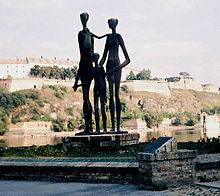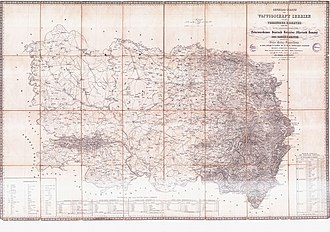Vojvodina
![]()
The title of this article is ambiguous. For other meanings, see Vojvodina (disambiguation).
45.39520.034Coordinates: 45° 24′ N, 20° 2′ E
· 
"Traditional Coat of Arms"
· 
"Traditional Flag"
Vojvodina [ˈvɔjvɔˌdina] (Serbian Cyrillic Војводина, German Wojwodina or Woiwodina, Hungarian Vajdaság) is an autonomous province in the Republic of Serbia. It makes up the part of the country north of the Sava and Danube rivers, with its administrative border running from the west mostly along the Sava (at the Belgrade district with a bend towards the north) and further east towards the Romanian border almost continuously along the Danube. Administrative headquarters is Novi Sad, the second largest city in Serbia.
Vojvodina is home to many different ethnic groups. In addition to Serbs, who make up the absolute majority of the population with about 66.76 percent (2011), the recognized autochthonous minorities living in Vojvodina include Hungarians, Slovaks, Croats, Romanians, Bunjevats, Šokci, Russins (Ruthenians), Roma, Germans and Bulgarians.
Geography
The largest part of the province is covered by the Pannonian Plain. In Syrmia, the Fruška Gora, which rises to just over 500 m, runs through the province. Since 1960, the area around the low mountain range has been a national park, which has also been nominated for the UNESCO World Natural and Cultural Heritage List. The foothills of the Carpathians rise in the far east near Vršac. The highest peak in Vojvodina, Gudurički vrh, is also located here at an altitude of 641 metres. This makes Vojvodina an exception in comparison to the rest of Serbia, which is mostly mountainous.
Vojvodina is crossed by three major rivers. The Danube first forms the state border to the west and then flows through the province. From the north runs the Tisza and from the west flows the Sava towards the Danube, both of which ultimately flow into Vojvodina outside of Belgrade. Towards the east, the Danube divides Serbia into central Serbia on the one hand and the province of Vojvodina on the other.
Vojvodina is at the same time divided by these rivers into three historical regions: Syrmia, Banat and Batschka. In the southwest, between the Danube and the Sava, lies Syrmia (Serbian: Срем / Srem). To the north of Syrmia is the Batschka (Serbian: Бачка / Bačka). The Danube forms both the western border and the southern border here, as the river changes its course here towards the south and continues to flow in an easterly direction. The Tisza River is the border between the Batschka and the Banat. The Banat lies east of the Tisza and north of the Danube. The Banat is divided by the state border in the east with Romania into a Serbian and Romanian part.
The administrative headquarters is Novi Sad, the second largest city in Serbia. Other important cities are Ruma, Inđija, Sremski Karlovci and Sremska Mitrovica in Syrmia; Subotica, Sombor, Vrbas, Bačka Topola and Bačka Palanka in Batschka; and Zrenjanin, Kikinda, Pančevo and Vršac in Banat. In early times, the Pannonian Sea (also Pannonian Lake or Lake Pannon) was located here. As a result, the fertile soil of Vojvodina consists partly of deposits of marine fossils. Therefore, agriculture is very productive, which is why it is an important economic sector in Vojvodina.

The interflow Syrmia in a Landsat 8 ETM+ image, March 12, 2014 (infrared false color).
History
Vojvodina in the Habsburg Empire
The name Vojvodina is borrowed from the Serbian Vojvodstvo for army command or Vojvode for army commander. It was first mentioned in May 1848 in the Proclamation of the Voivodeship of Serbia and Temes Banat for the territories of Syrmia, Banat, Bácska and Baranya in response to the Hungarian uprising against the Austrian Empire.
Before 1848, the region was part of the Kingdom of Hungary, which in turn belonged to the Habsburg Monarchy. Originally, Vojvodina consisted of the areas of Bačka and West Banat, where the Danube Swabians had been settled earlier in several so-called Swabian raids in order to cultivate the arable land. The basis for the planned settlement of the ethnic German population in Vojvodina was the Austrian settlement policy (colonization patent of Empress Maria Theresa, settlement patent of Emperor Joseph II, policy of Prince Eugene of Savoy) to settle the Pannonian plain (Danube plain), which had been largely depopulated after the Turkish wars, with taxpayers. Thereby the historical and local assignment of the Danube Swabians for Vojvodina also overlaps with the Buchenland Germans and the Yugoslav Hungarians.
In 1850, the crown land of the Voivodeship of Serbia and Temes Banat was established, but it was dissolved in 1860 and the political order of before 1848/1850 was restored. In 1868, Vojvođanska banka was founded, and as one of the oldest companies in Serbia, it still exists today.
Until the end of the First World War in 1918, Vojvodina belonged to Austria-Hungary.
Interwar period and Kingdom of Yugoslavia
After the victory of the Entente in the First World War, to which Serbia also belonged, Vojvodina was annexed to the newly founded state of Serbs, Croats and Slovenes. Due to the dissolution of the Danube Monarchy, the historical region of Banat was divided into three parts by the Treaty of Trianon. Romania received the largest part - located around Timisoara. The second largest part was given to Serbia - around Novi Sad, today's Vojvodina. The smallest part was given to Hungary - around Szeged. The National Assembly of Vojvodina decided on 25 November 1918 to join Serbia.
Within the new state, which from 1929 was called the Kingdom of Yugoslavia, Vojvodina, together with Syrmia and part of closer Serbia south of the Danube, formed the Danube Banschaft (Serbian: Dunavska banovina) with Novi Sad as its capital. In the 1931 census, 342,853 inhabitants of Vojvodina described themselves as "Germans" (i.e., of German descent and German-speaking). Another 10,751 Danube Swabians had their residence in Belgrade.
In 1941, German and Hungarian troops invaded Vojvodina. Germany and Hungary then divided it up: Baranja and Bačka fell to Hungary, Syrmia to Croatia, and the Banat was added to a Serbian state under German administration. In 1942, there was the infamous "raid" in Novi Sad. There, from January 21 to 23, 1942, the Hungarian commander General Ferenc Feketehalmy-Czeydner had 1246 civilians shot, among them 809 Jews, 375 Serbs, 8 Germans and 18 Hungarians. Several hundred civilians were thrown under the ice of the frozen Danube and drowned. Today, a sculpture cast in bronze depicting a man, a woman and a child commemorates the act. Behind it are plaques engraved in Serbian and Hebrew script with the names of the identified victims. Throughout the war, 50,000 lives were lost and 280,000 were taken prisoner. One of the fiercest battles on the territory of the former Yugoslavia was fought by Josip Broz Tito's partisans and the German and Croatian fascists in the Srem (Sremski Front). In April 1945 Vojvodina was finally taken by the Red Army and immediately afterwards by the partisans. Most of the Danube Swabians living there were dispossessed and expelled. Thousands of those who remained were interned in camps in Jarek, Gakovo, Novi Sad, Rudolfsgnad and other places and died there, 6500 in the Jarek camp alone. In 1944 there had already been serious attacks on the Hungarian minority after Serbian partisans had driven out the Hungarian troops allied with Germany.
Autonomous Province of Vojvodina
In 1945, a new political entity called Vojvodina was created, the Autonomous Province of Vojvodina. In that year, Vojvodina was annexed to the Yugoslav Republic of Serbia as an autonomous province with Novi Sad as its administrative headquarters in its current borders (i.e. without Baranja, but with the largest part of Syria). In 1974, the autonomous status was extended by a constitutional amendment of Josip Broz Tito. After months of protests by Kosovo Serbs against the provincial party leadership in the summer of 1988, supported by the CC of the Union of Communists of Serbia and Slobodan Milošević, the leadership was forced to resign on 6 October 1988 and replaced by cadres loyal to the CC. As part of the constitutional amendments of that year, at the beginning of 1989 Slobodan Milošević effectively abolished Vojvodina's autonomy. According to the 1990 Constitution of the Republic of Serbia, the province's autonomy status included far fewer powers than had been the case in all previous socialist constitutions. It was only after his fall that Vojvodina regained some of its old powers through the Omnibus Law in 2002, although still within the framework of the 1990 Constitution. The new Constitution of Serbia in 2006 added financial autonomy to Vojvodina's autonomy. In October 2008, the Vojvodina parliament passed a draft constitution that seeks to return to the extensive autonomy status enjoyed before the Milošević era. The opposition sees this as a separatist policy. The entry into force of the new constitution depends on the approval of the central parliament in Belgrade.
Vote on constitutional amendment
The DS (Democratic Party), LSV (League of Social Democrats of Vojvodina) and NDS (New Democratic Party) voted on 23 September 2014 for a constitutional amendment. Thereby, the status for the whole of Serbia is to be redrafted and declared, where Vojvodina is to be granted more autonomy and independence. The SNS (Serbian Progressive Party), the SPS (Socialist Party of Serbia) and other small parties voted against.
Chairperson of the Executive Board (since 1991)
- Radoman Božović (1991)
- Jovan Radić (1991-1992)
- Koviljko Lovre (1992-1993)
- Boško Perošević (1993-2000)
- Damnjan Radenković (2000)
- Đorđe Đukić (2000-2004)
- Bojan Pajtić (2004-2014)
- Igor Mirović (2014-)

Memorial to the victims of the raid against Jews and Serbs in Novi Sad in 1942

Voivodeship of Serbia and Temes Banat (1853)
Search within the encyclopedia